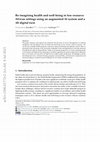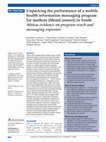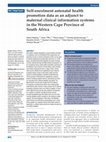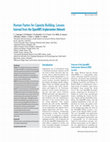Papers by Christopher Seebregts
South African Medical Journal, Feb 26, 2020
This open-access article is distributed under Creative Commons licence CC-BY-NC 4.0.

arXiv (Cornell University), May 29, 2023
This paper discusses and explores the potential and relevance of recent developments in artificia... more This paper discusses and explores the potential and relevance of recent developments in artificial intelligence (AI) and digital twins for health and well-being in low-resource African countries. We use the case of public health emergency response to disease outbreaks and epidemic control. There is potential to take advantage of the increasing availability of data and digitization to develop advanced AI methods for analysis and prediction. Using an AI systems perspective, we review emerging trends in AI systems and digital twins and propose an initial augmented AI system architecture to illustrate how an AI system can work with a 3D digital twin to address public health goals. We highlight scientific knowledge discovery, continual learning, pragmatic interoperability, and interactive explanation and decision-making as essential research challenges for AI systems and digital twins.
I am grateful to Professor M. Berman as well as Drs. George Davidson and David Ross for discussio... more I am grateful to Professor M. Berman as well as Drs. George Davidson and David Ross for discussions and critical evaluation of the work. I also wish to thank Mr. David Woolley for excellent technical assistance, and Mr. R. Alexander and Mr. M. Smith for the routine preparation of SR vesicles. I am grateful to Professor L. Purves for assistance with amino acid analysis and sequencing techniques, to Mr. David Jeans for performing the pH-stat measurements, to Mr. Steven King for the fluorescence titration measurements, and to Dr. R. Milton for the gift of synthetic peptide standards. Financial assistance for the duration of this study was provided in part by the Council for Scientific and Industrial Research (CSIR).

BACKGROUND Electronic Health Records (EHRs) play an increasingly important role in the delivery o... more BACKGROUND Electronic Health Records (EHRs) play an increasingly important role in the delivery of HIV care in low-and-middle-income countries. The data collected is used for direct clinical care, quality improvement activities, reporting and clinical research. Despite widespread EHR use for HIV care in East Africa, and countries like Nigeria, Mozambique and Haiti, challenges remain especially with achieving and maintaining high quality data. OBJECTIVE To determine factors influencing data quality in a large scale EHR deployment and potential strategies to improve quality. METHODS We carried out a data quality evaluation in 50 health facilities in Rwanda using the OpenMRS EHR systems for HIV care. The sites were part of a larger randomized controlled trial and half of the sites had an enhanced version of the EHR with clinical decision support alerts. Trained data collectors visited 50 health facilities to collect 28 variables from both paper charts and the EHR system using the ODK a...

Background: Intestinal macrophages are key regulators of inflammatory responses to the gut microb... more Background: Intestinal macrophages are key regulators of inflammatory responses to the gut microbiome and play a central role in maintaining tissue homeostasis and epithelial integrity. However, little is known about the role of these cells in HIV infection, a disease fuelled by intestinal inflammation, a loss of epithelial barrier function and increased microbial translocation (MT). Methods: Phenotypic and functional characterization of intestinal macrophages was performed for 23 African AIDS patients with chronic diarrhea and/or weight loss and 11 HIV-negative Africans with and without inflammatory bowel disease (IBD). AIDS patients were treated with cotrimoxazole for the prevention of opportunistic infections (OIs). Macrophage phenotype was assessed by flow cytometry and immuno-histochemistry (IHC); production of proinflammatory mediators by IHC and Qiagen PCR Arrays; in vitro secretion of cytokines by the Bio-Plex Suspension Array System. Statistical analyses were performed using Spearman's correlation and Wilcoxon matched-pair tests. Results between groups were analyzed using the Kruskal-Wallis with Dunn's post-test and the Mann-Whitney U tests. Results: None of the study participants had evidence of enteric co-infections as assessed by stool analysis and histology. Compared to healthy HIV-negative controls, the colon of AIDS patients was highly inflamed with increased infiltration of inflammatory cells and increased mRNA expression of proinflammatory cytokine (tumour necrosis factor (TNF)-α, interleukin (IL)-1β, IFN-γ, and IL-18), chemokines (chemokine (C-C motif) ligand (CCL)2 and chemokine (C-X-C) motif ligand (CXCL)10) and transcription factors (TNF receptor-associated factor (TRAF)6 and T-box (TXB)21). IHC revealed significant co-localization of TNF-α and IL-1β with CD68 + cells. As in IBD, HIV was associated with a marked increase in macrophages expressing innate response receptors including CD14, the co-receptor for lipopolysaccharide (LPS). The frequency of CD14 + macrophages correlated positively with plasma LPS, a marker of MT. Total unfractionated mucosal mononuclear cells (MMC) isolated from the colon of AIDS patients, but not MMC depleted of CD14 + cells, secreted increased levels of proinflammatory cytokines ex vivo in response to LPS.

BMJ Global Health, 2018
Despite calls to address broader evidence gaps in linking digital technologies to outcome and imp... more Despite calls to address broader evidence gaps in linking digital technologies to outcome and impact level health indicators, limited attention has been paid to measuring processes pertaining to the performance of programs. In this paper, we assess the program reach and message exposure of a mobile health information messaging program for mothers (MomConnect) in South Africa. In this descriptive study, we draw from system generated data to measure exposure to the program through registration attempts and conversions, message delivery, opt-outs and drop-outs. Using a logit model, we additionally explore determinants for early registration, opt-outs and drop-outs. From August 2014 to April 2017, 1 159 431 women were registered to MomConnect; corresponding to half of women attending antenatal care 1 (ANC1) and nearly 60% of those attending ANC1 estimated to own a mobile phone. In 2016, 26% of registrations started to get women onto MomConnect did not succeed. If registration attempts w...

BMJ global health, 2018
Information systems designed to support health promotion in pregnancy, such as the MomConnect pro... more Information systems designed to support health promotion in pregnancy, such as the MomConnect programme, are potential sources of clinical information which can be used to identify pregnancies prospectively and early on. In this paper we demonstrate the feasibility and value of linking records collected through the MomConnect programme, to an emergent province-wide health information exchange in the Western Cape Province of South Africa, which already enumerates pregnancies from a range of other clinical data sources. MomConnect registrations were linked to pregnant women known to the public health services using the limited identifiers collected by MomConnect. Three-quarters of MomConnect registrations could be linked to existing pregnant women, decreasing over time as recording of the national identifier decreased. The MomConnect records were usually the first evidence of pregnancy in pregnancies which were subsequently confirmed by other sources. Those at lower risk of adverse pr...

South African Journal of Information and Communication, 2007
The Dutch have an idiom for speaking directly and unashamedly, they call it "speaking from the ba... more The Dutch have an idiom for speaking directly and unashamedly, they call it "speaking from the back of your tongue". 1 Stephen Lewis, in his 2005 Massey Lectures, although rhetorical, discloses deep personal perceptions of the workings of the UN and other multilateral systems and candidly attacks national leaders. Via his disclosures, Lewis breaks with formal diplomacy. At the time of writing, Lewis was the UN Secretary-General's special envoy for HIV/Aids in Africa, and this is a book of his five-part lecture series broadcast by the Canadian Broadcasting Corporation (CBC) radio during October 2005. No one is spared from his punishing criticism: not the United Nations (UN) diplomats; the World Bank and International Monetary Fund (IMF) policies and statements; its high ranking officials' behaviour; the United States-and the President's Emergency Plan for Aids Relief (PEPFAR); Tony Blair; Bob Geldof; the Swazi King, nor South Africa's President or Minister of Health. Lewis also discloses his own failure to speak out at times. In Race Against Time, he provides an unprecedented level of disclosure.

The challenge of scaling up HIV treatment in Africa has led to a new emphasis on improving health... more The challenge of scaling up HIV treatment in Africa has led to a new emphasis on improving health systems in impoverished areas. One aspect of this is the development and deployment of electronic medical record systems to support HIV and TB treatment. In this paper we describe the design and implementation of a new medical record architecture to support an HIV treatment program in rural Rwanda. The architecture is called OpenMRS and it has been developed to address the problem of configuring EMR systems to suit new sites, languages and diseases. OpenMRS uses a data dictionary called the concept dictionary to represent all the possible data items that can be collected. This allows new items to be added to the system by non-programmers. In addition, there are form creation tools that use drag and drop web technologies to simplify form construction. The OpenMRS system was first implemented in Kenya in February 2006 and then in Rwanda in August 2006. The system is now functioning well and we are developing extensions to improve the support for the clinic. These include improved, easy to use reporting tools, support for additional clinical problems including nutrition and child health, better database synchronization tools, and modules to collect laboratory data and support the pharmacy. The system is also in use in South Africa and Lesotho and is being deployed in Tanzania and Uganda.
Archives of Internal Medicine, 2008
Archives of Internal Medicine, a bi-monthly professional medical journal published by the America... more Archives of Internal Medicine, a bi-monthly professional medical journal published by the American Medical Association, publishes original peer-reviewed research articles on internal medicine topics.
Journal of Biological Chemistry, Feb 1, 1989
Information and communication technology for health (ICT4H) can provide solutions for health prac... more Information and communication technology for health (ICT4H) can provide solutions for health practices in low resource settings leading to improved health and health care. The presentation provides perspectives on health information systems that can be integrated into African healthcare systems. Possible designs and methods are surveyed in relation to the Open Architecture, Standards and Information Systems (OASIS) framework and with reference to examples such as the WHO electronic Recording and Reporting Portal

ISSUES: Paper-based structured clinical records are widely used for monitoring and evaluating the... more ISSUES: Paper-based structured clinical records are widely used for monitoring and evaluating the public sector HIV antiretroviral (ART) treatment program in South Africa. Computerized systems are sometimes used for operational data capture but are usually limited to individual clinics and hospitals. Important information also exists in other databases. A requirement exists to collate information into electronic format and integrate data from a variety of sources to facilitate reporting and quality controls. DESCRIPTION: Handheld computers (PDA's) were used to collate data from paper records at urban and rural sites during the first nine months of the ART roll-out program in the Free State province of South Africa. Thereafter a commercial online computer system (Meditech) was implemented. A Microsoft SQL Server 2000 database server was used to deploy the information into a relational and dimensional format using Microsoft Data Transformation Services. External laboratory and res...
Emerging Infectious Diseases
Lecture Notes in Computer Science, 2017
Poor adherence to prescribed treatment is a major factor contributing to tuberculosis patients de... more Poor adherence to prescribed treatment is a major factor contributing to tuberculosis patients developing drug resistance and failing treatment. Treatment adherence behaviour is influenced by diverse personal, cultural and socioeconomic factors that vary between regions and communities. Decision network models can potentially be used to predict treatment adherence behaviour. However, determining the network structure (identifying the factors and their causal relations) and the conditional probabilities is a challenging task. To resolve the former we developed an ontology supported by current scientific literature to categorise and clarify the similarity and granularity of factors.

Yearbook of Medical Informatics, 2010
Summary Objectives: Theoverallobjectiveofthisprojectwastoinvestigateways to strengthen the OpenMR... more Summary Objectives: Theoverallobjectiveofthisprojectwastoinvestigateways to strengthen the OpenMRS community by (i) developing capacity and implementing a network focusing specifically on the needs of OpenMRS implementers,(ii) strengthening community-driven aspects of OpenMRS and providing a dedicated forum for implementation-specific issues, and; (iii) providing regional support for OpenMRS implementations as well as mentorship and training. Methods: Themethodsusedincluded(i)face-to-facenetworkingusing meetings and workshops; (ii) online collaboration tools, peer support and mentorship programmes; (iii) capacity and community development programmes, and; (iv) community outreach programmes. Results: Thecommunity-driven approach,combined withafewsimple interventions,has been a key factor in the growth and success of the OpenMRS ImplementersNetwork.Ithascontributed toimplementations in at least twenty-three different countries using basic online tools; and provided mentorship and peer...

Patient Preference and Adherence, 2016
Purpose: Adherence behavior is a complex phenomenon influenced by diverse personal, cultural, and... more Purpose: Adherence behavior is a complex phenomenon influenced by diverse personal, cultural, and socioeconomic factors that may vary between communities in different regions. Understanding the factors that influence adherence behavior is essential in predicting which individuals and communities are at risk of nonadherence. This is necessary for supporting resource allocation and intervention planning in disease control programs. Currently, there is no known concrete and unambiguous computational representation of factors that influence tuberculosis (TB) treatment adherence behavior that is useful for prediction. This study developed a computer-based conceptual model for capturing and structuring knowledge about the factors that influence TB treatment adherence behavior in sub-Saharan Africa (SSA). Methods: An extensive review of existing categorization systems in the literature was used to develop a conceptual model that captured scientific knowledge about TB adherence behavior in SSA. The model was formalized as an ontology using the web ontology language. The ontology was then evaluated for its comprehensiveness and applicability in building predictive models. Conclusion: The outcome of the study is a novel ontology-based approach for curating and structuring scientific knowledge of adherence behavior in patients with TB in SSA. The ontology takes an evidence-based approach by explicitly linking factors to published clinical studies. Factors are structured around five dimensions: factor type, type of effect, regional variation, cross-dependencies between factors, and treatment phase. The ontology is flexible and extendable and provides new insights into the nature of and interrelationship between factors that influence TB adherence.

Uploads
Papers by Christopher Seebregts